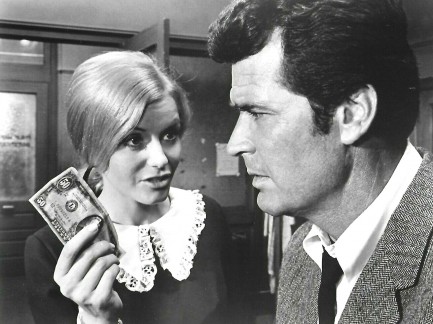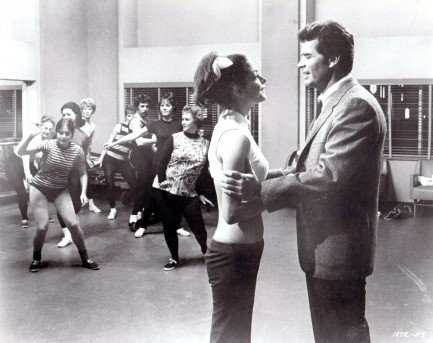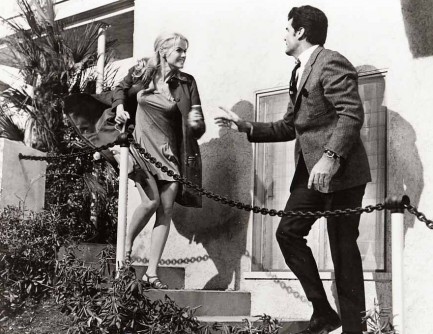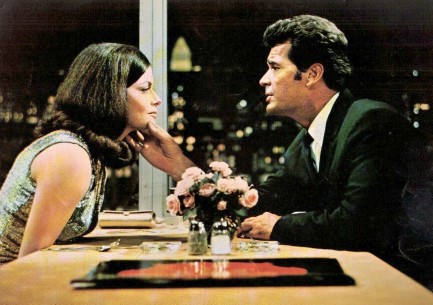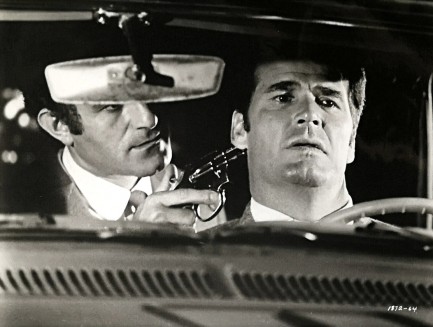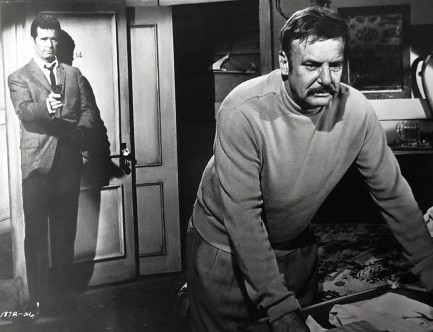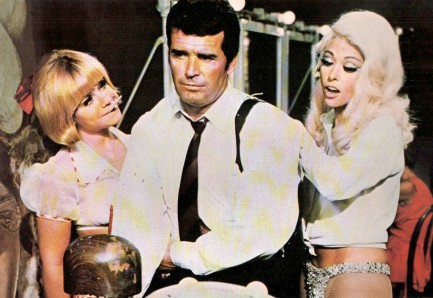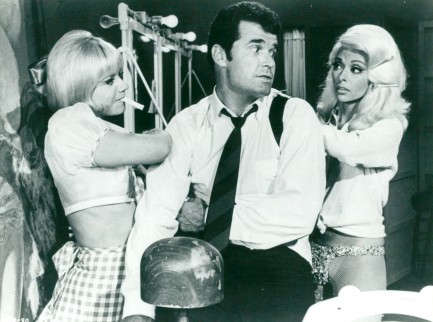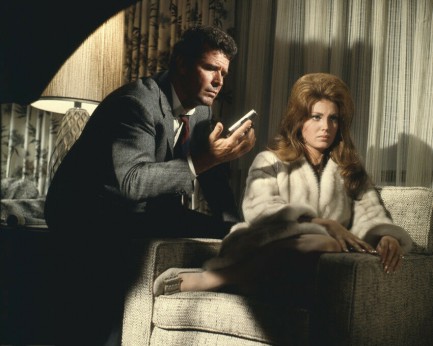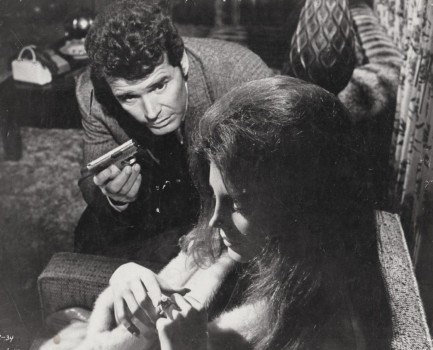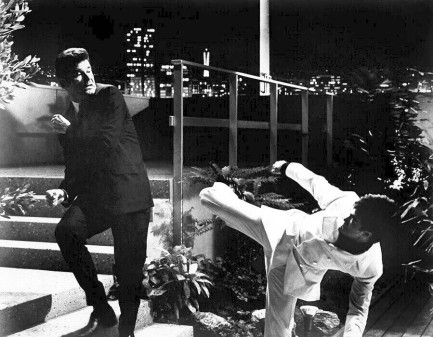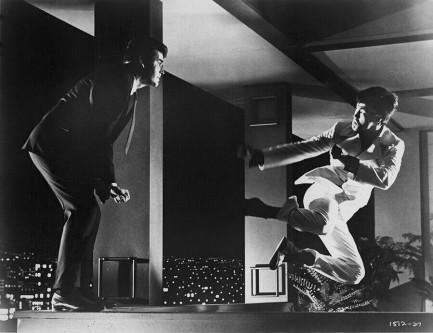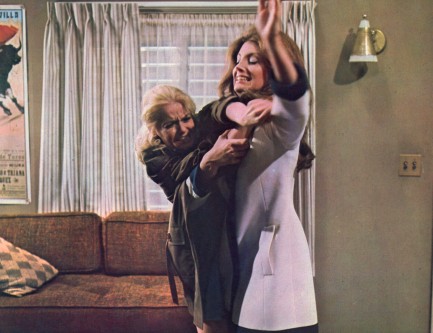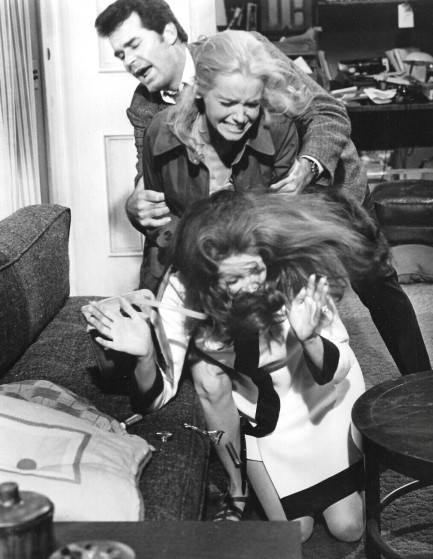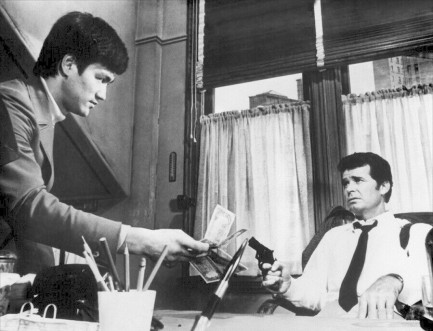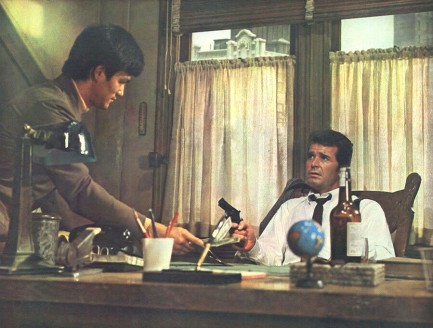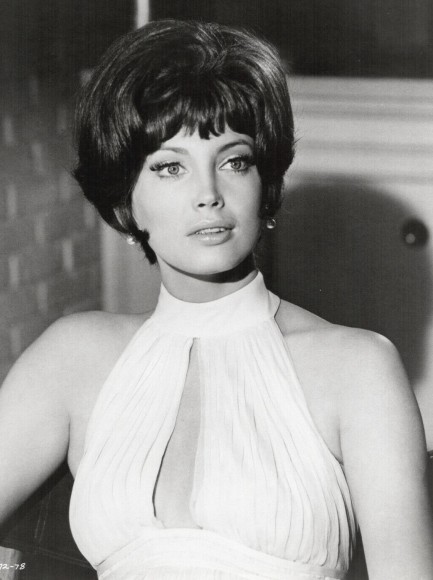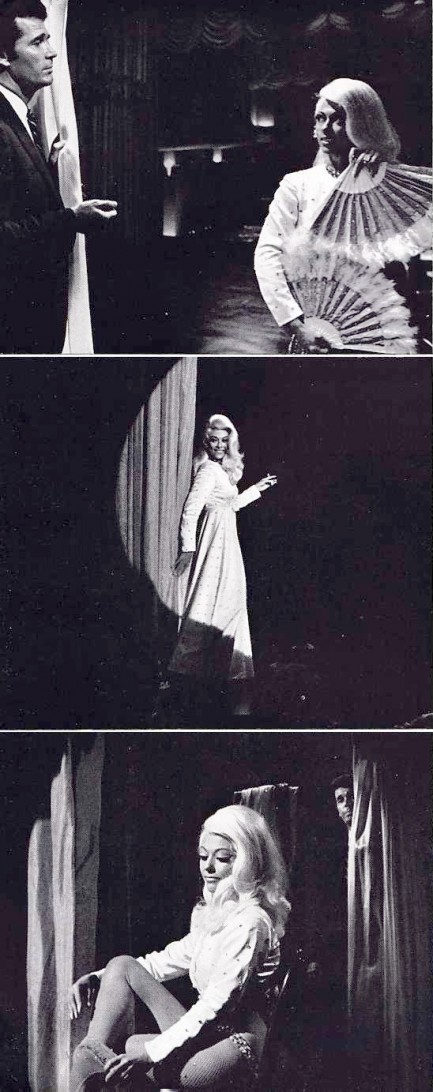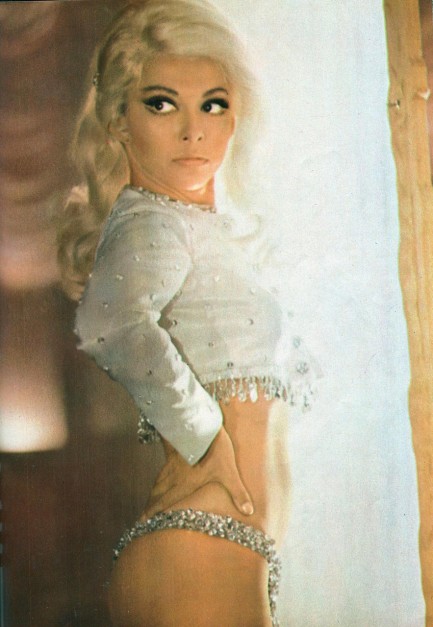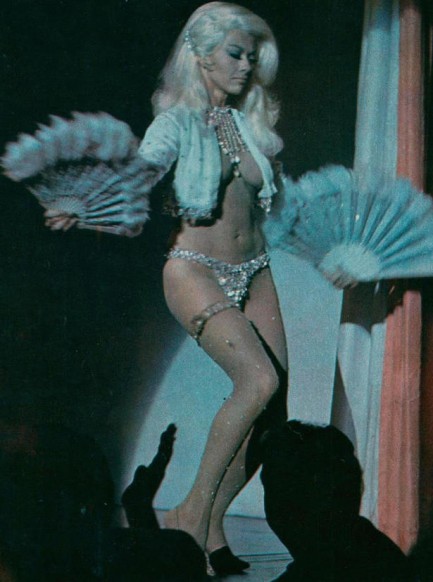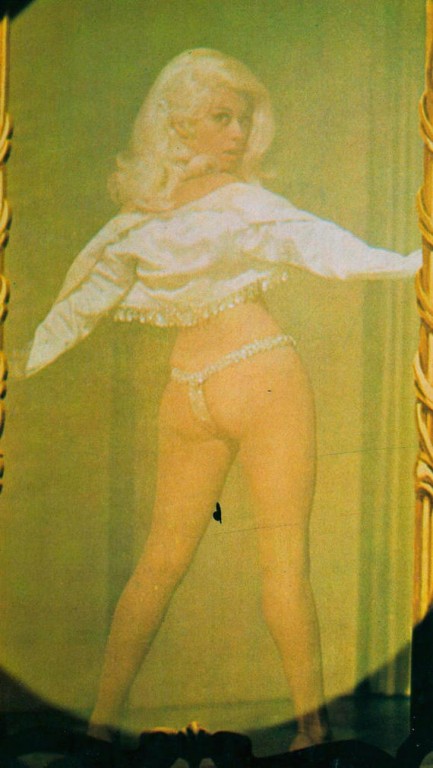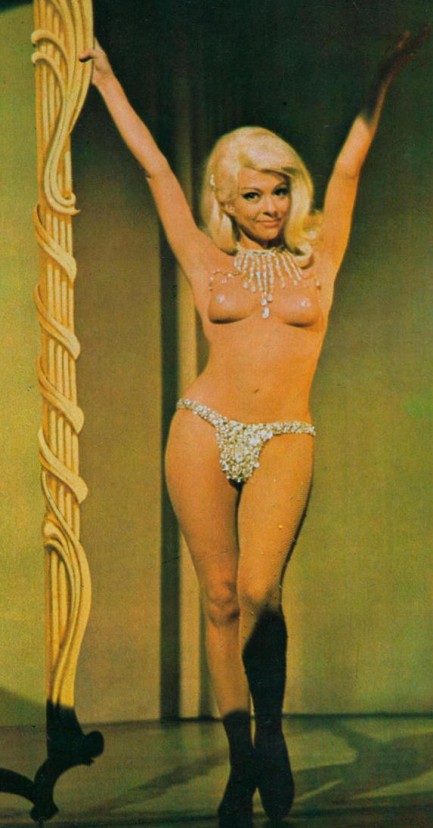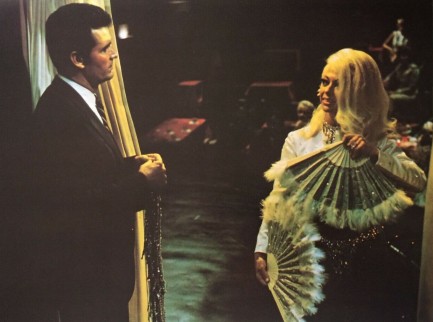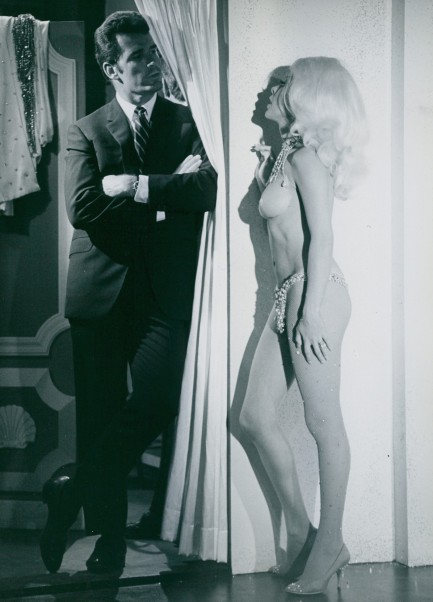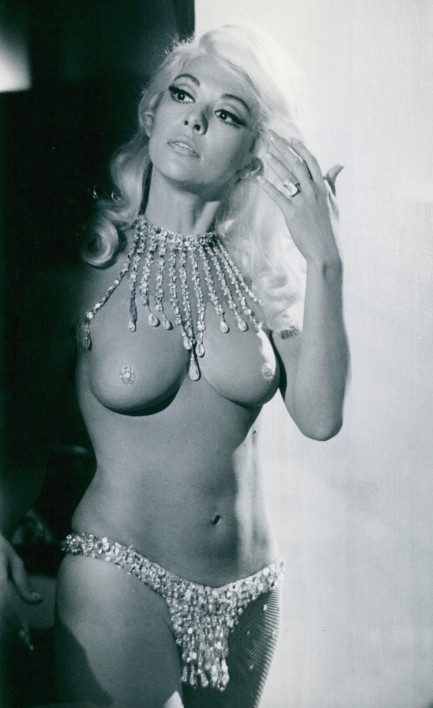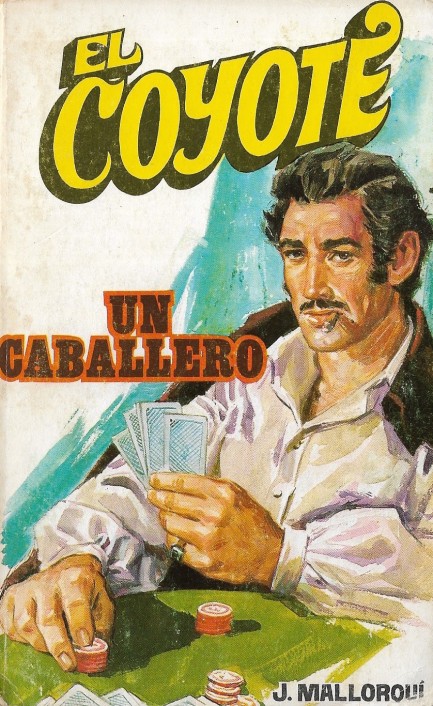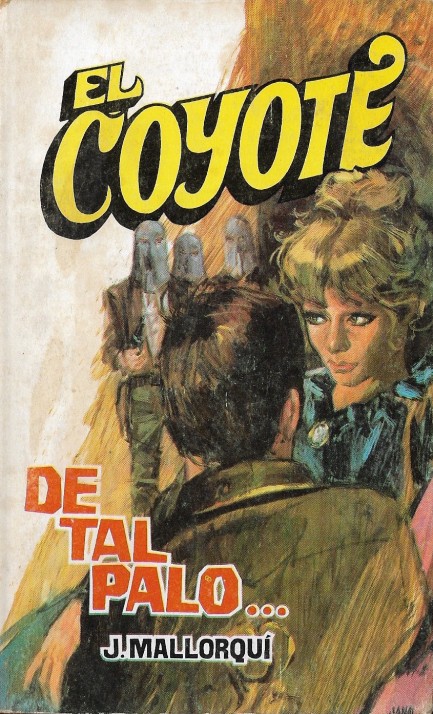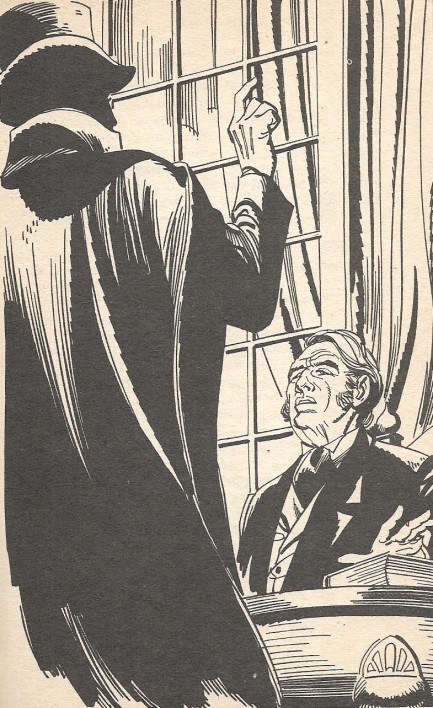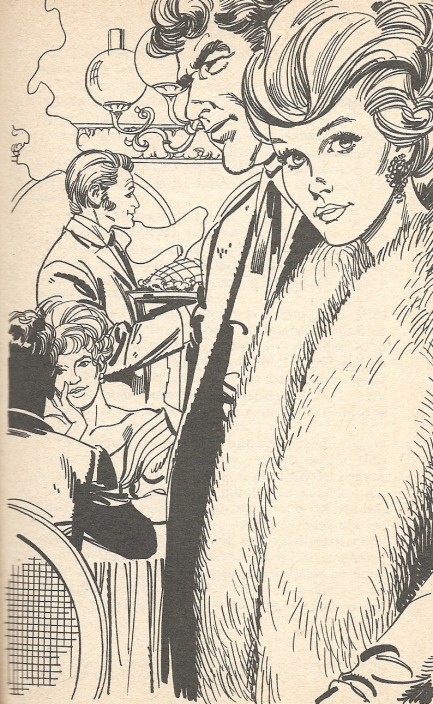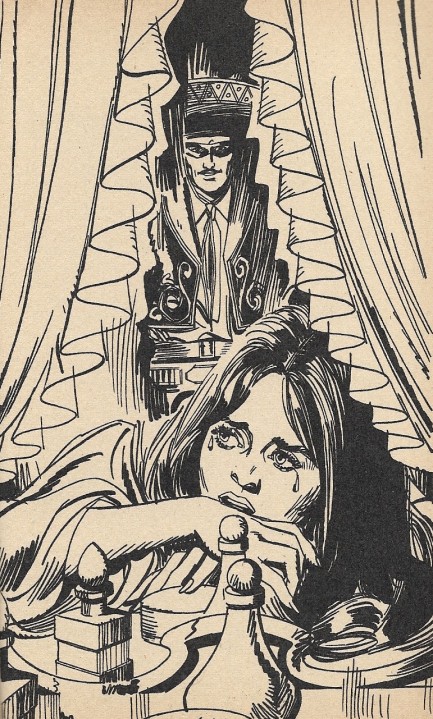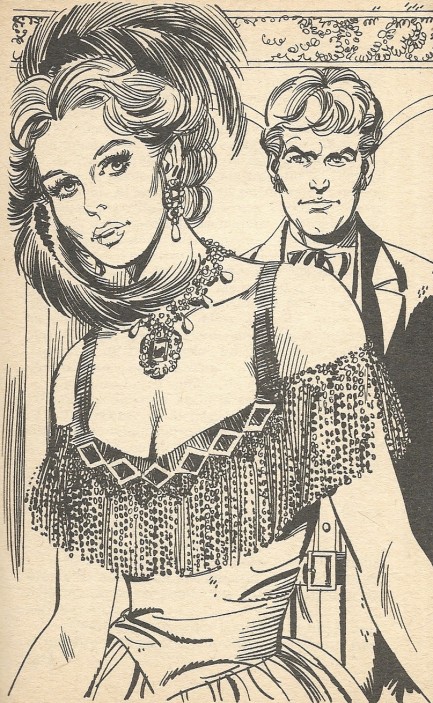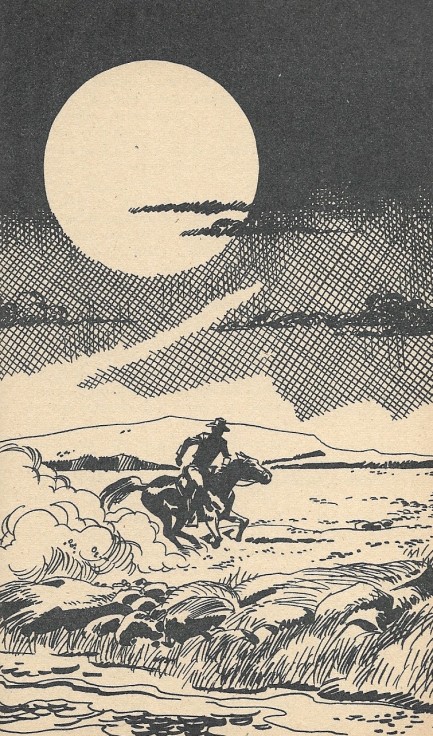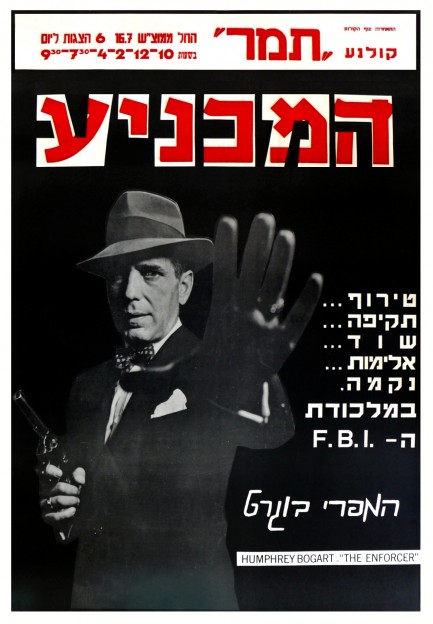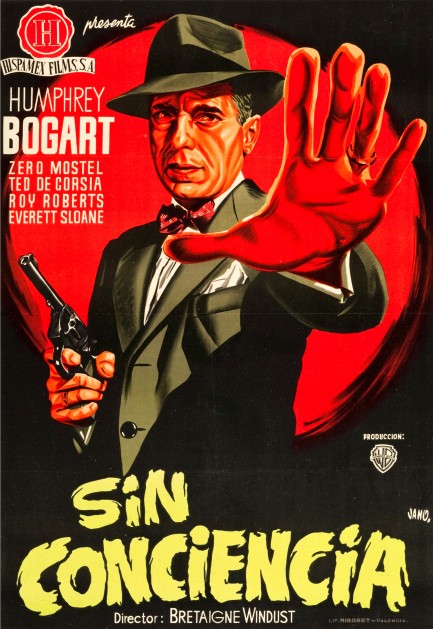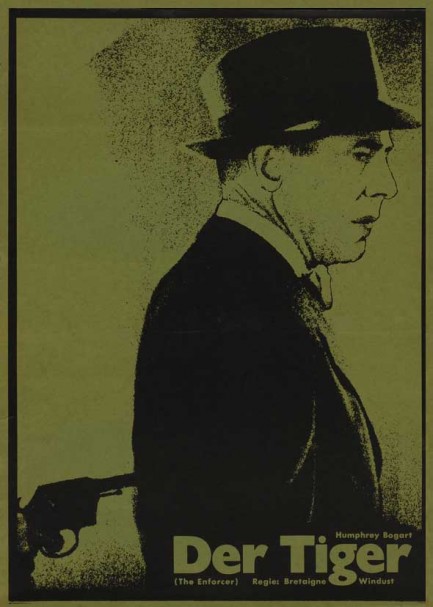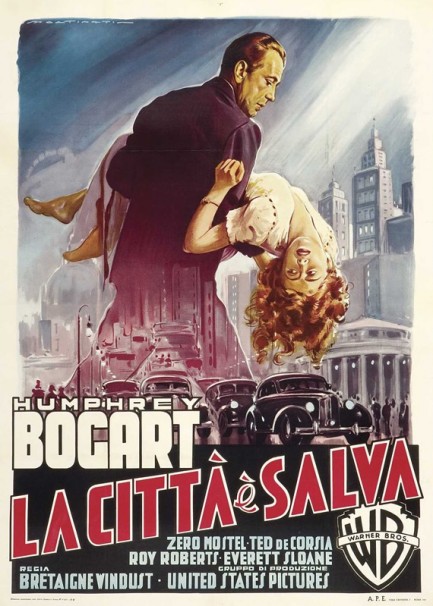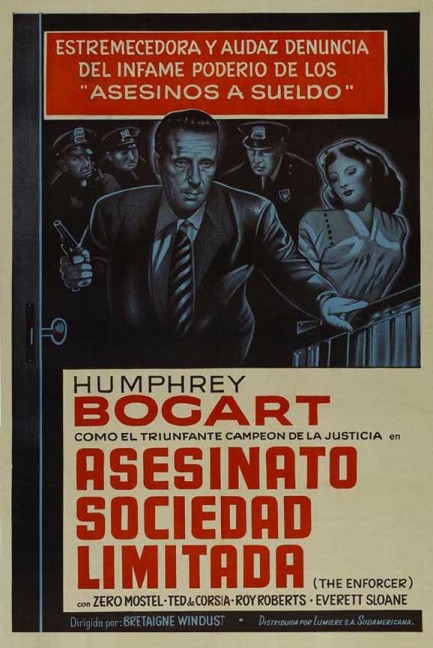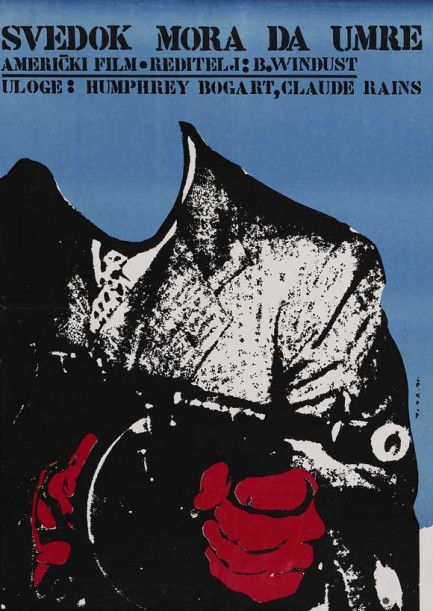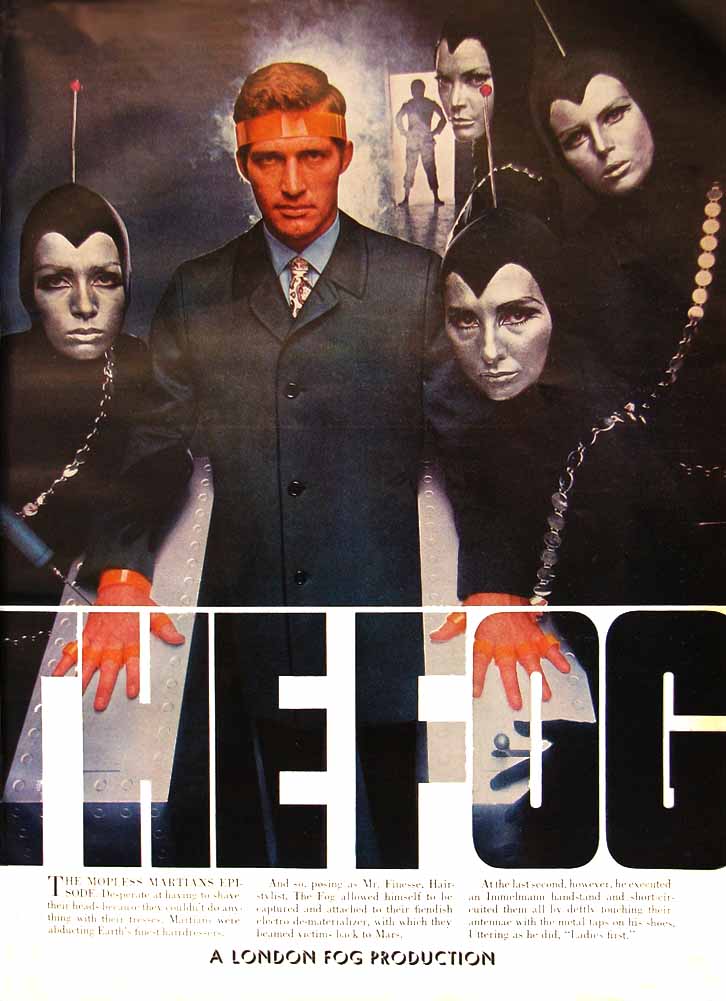 Some love lasts forever. Other times it doesn't survive the wedding night. 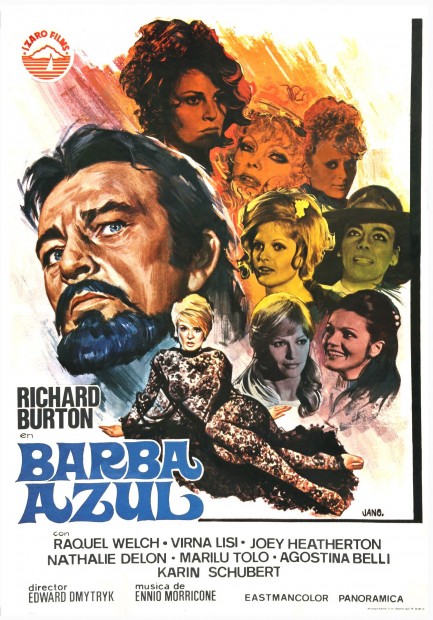
 Another of the movies we watched recently was Bluebeard, a castle and dungeon-style, quasi gothic horror flick about a folk tale character who murders a series of wives. Its Spanish poster was the best of those we saw, and we chose today to share it because the film premiered in Spain today in 1974, after opening in the U.S. two years earlier. Another of the movies we watched recently was Bluebeard, a castle and dungeon-style, quasi gothic horror flick about a folk tale character who murders a series of wives. Its Spanish poster was the best of those we saw, and we chose today to share it because the film premiered in Spain today in 1974, after opening in the U.S. two years earlier.
This piece was painted and collaged from photos by Fernandez Zarza-Pérez, also known as Jano, now a regular visitor to Pulp Intl. Just for the sake of it, we've also included the U.S. poster at right (or above if you're on a mobile device). You can see that it's built fully around a photo-illustration, and while it's interesting, we thought Jano's work had a little more merit.
Bluebeard stars Richard Burton, who's supposed to be a great actor, but we have to admit we'd seen exactly zero of his acclaimed movies up to this point. He was a Shakespearean stage guy who transitioned to Hollywood in similar type roles, and being decidedly non-pulp in style, we've highlighted none here. He later made a couple of war movies, though, as well as the overbudget epic Cleopatra, and we might get around to those. Going on the example presented by Bluebeard, however, you'd have to conclude that he's a hack. Those who know more than us say that by the 1970s heavy drinking had impaired both his judgment and skill.
You'd think that a famous folk tale would provide a trove of potential cinematic possibilities to sift through, but Bluebeard is uninspiringly written, and the direction—from film noir vet Edward Dmytryk—presents little evidence of engagement with or inspiration by the material. The women Bluebeard murders are played by Karin Schubert, Nathalie Delon, Virna Lisi, sexy nun Raquel Welch, Marilú Tolo, Agostina Belli, and Joey Heatherton—not neccsarily in that order—plus Sybil Danning makes an appearance. Heatherton has the key role as Anne, the wife who elicits a confession from a psychologically tortured Bluebeard as to why he kills.
And the reason? Dude can't get it up. Therefore, in the era before little blue pills, as a prominent member of Austria's post-World War I patriarchal society, Bluebeard murders to keep his limpness secret. You'd think dying wives would destroy his matrimonial suitability, but at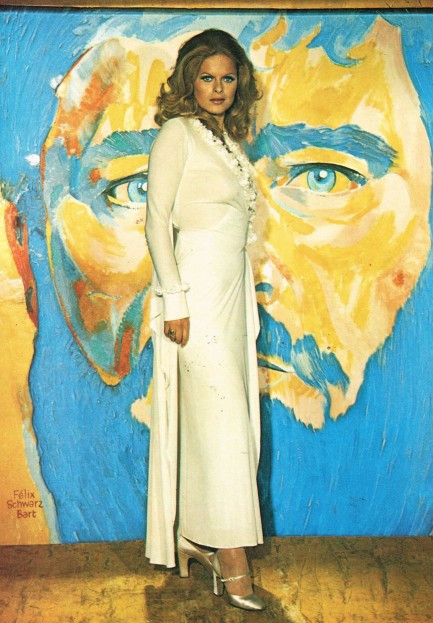 a certain point we suppose money papers over all flaws. Rich or not, though, never marry a guy who sits around with a raptor on his shoulder. And speaking of hunting, we should warn the kind-hearted that there's an extended hunting sequence in Bluebeard, and the animals are killed for real, in detailed action. We're talking several rabbits, a number of birds in flight, a couple of foxes, a boar, and a deer. a certain point we suppose money papers over all flaws. Rich or not, though, never marry a guy who sits around with a raptor on his shoulder. And speaking of hunting, we should warn the kind-hearted that there's an extended hunting sequence in Bluebeard, and the animals are killed for real, in detailed action. We're talking several rabbits, a number of birds in flight, a couple of foxes, a boar, and a deer.
Based on what we've written so far, you might think we're not recommending Bluebeard, but not so fast, friends. The female cast—to state the obvious—comprises some of the loveliest actresses of the era, and in diverse ways. Welch is sculpturally flawless, Lisi is ethereally beautiful, Toló is broodingly dark, and Heatherton, whose resting face is ingenuous and slightly open-mouthed as if she's always concentrating on a problem, can only be described as luscious. She also has one of cinema's all-time greatest hairdos. Is it pervy to say you should watch a movie solely for the beauty of its actresses? Probably—but it's the truth. The filmmakers must have agreed, because they published lots of nude production stills, when in fact the film has less skin. See below. 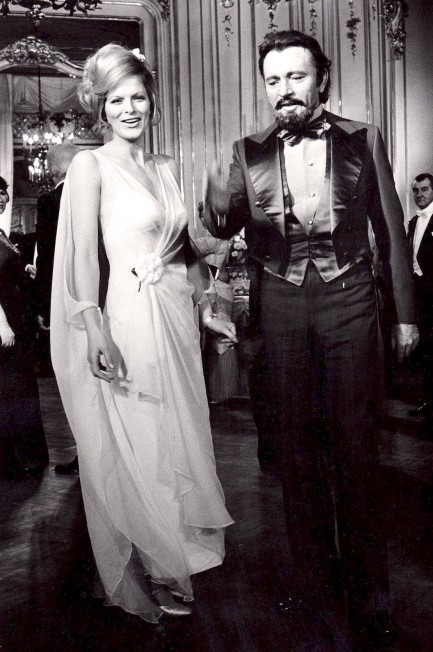 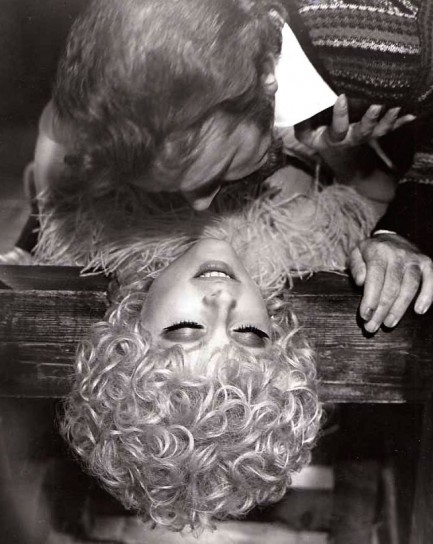 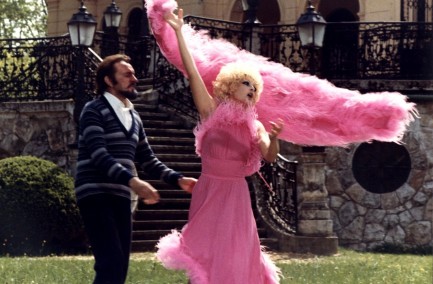 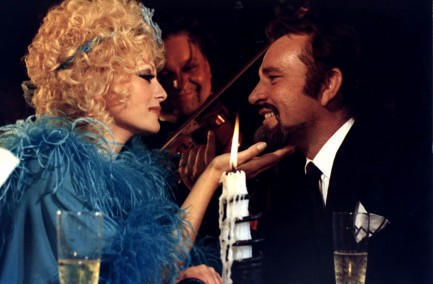 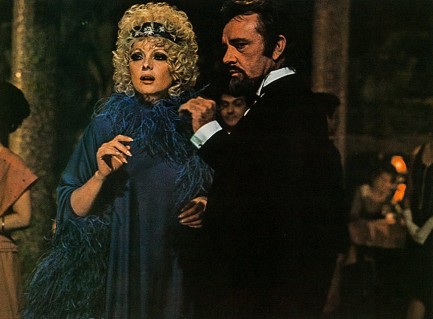 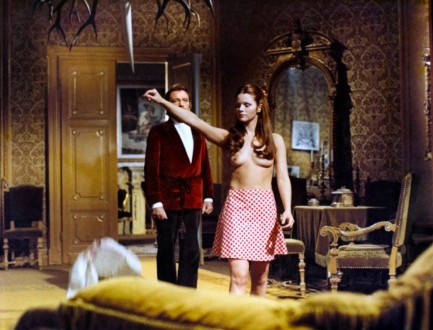 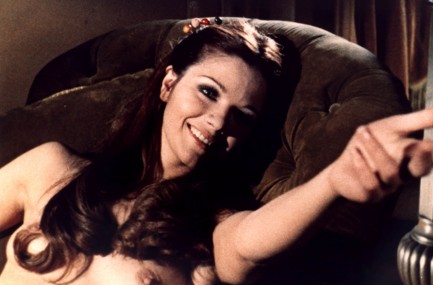 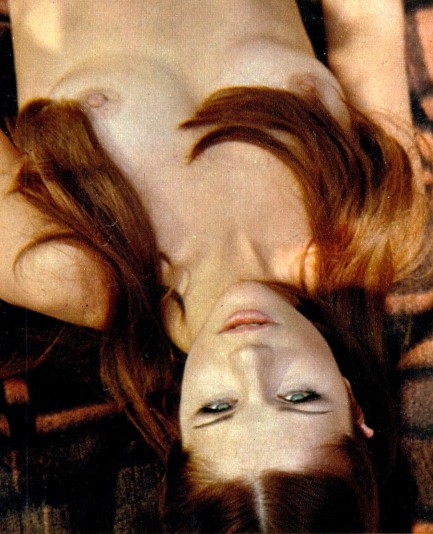 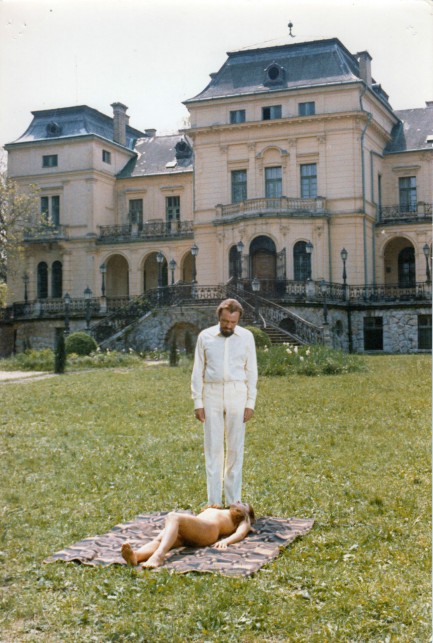 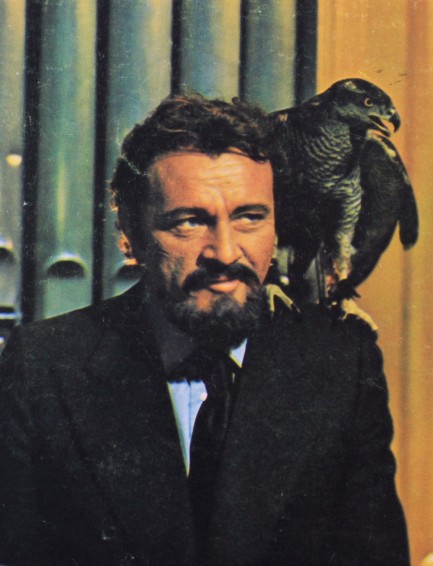 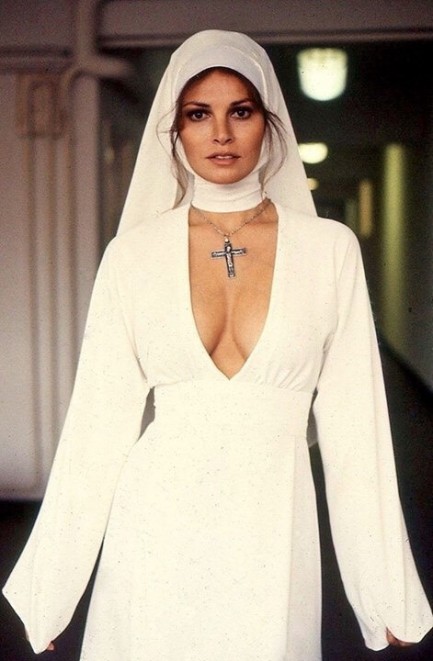 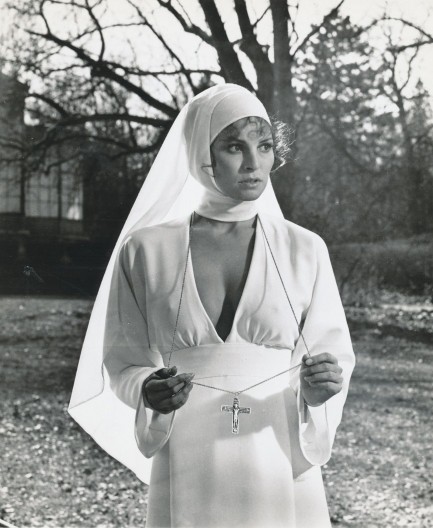  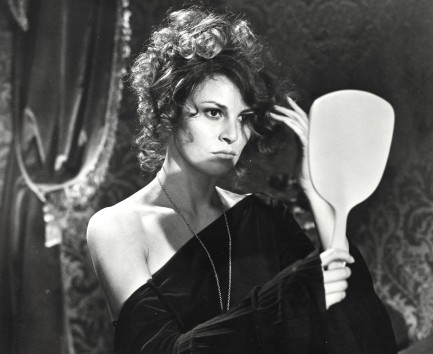 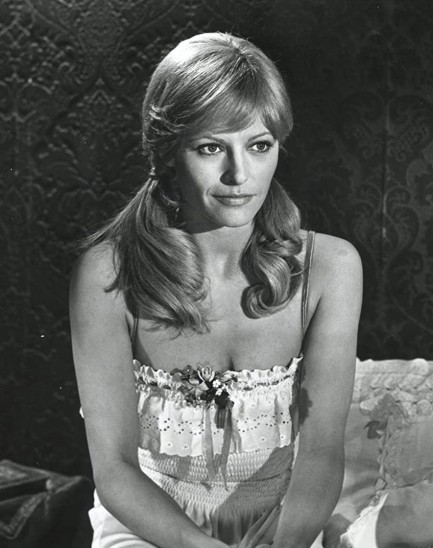 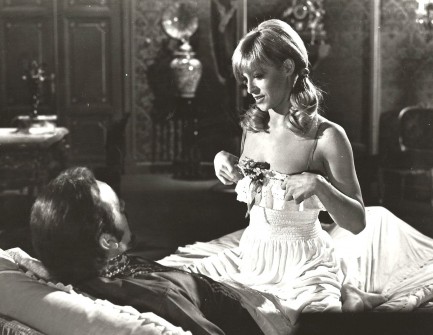 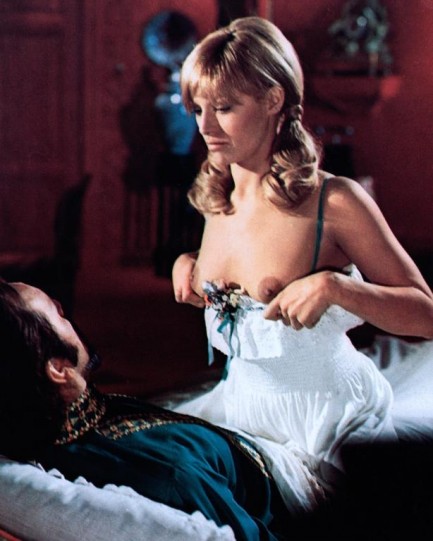 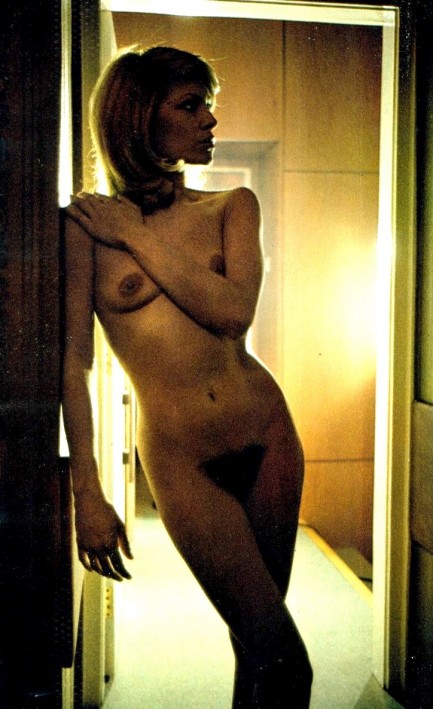 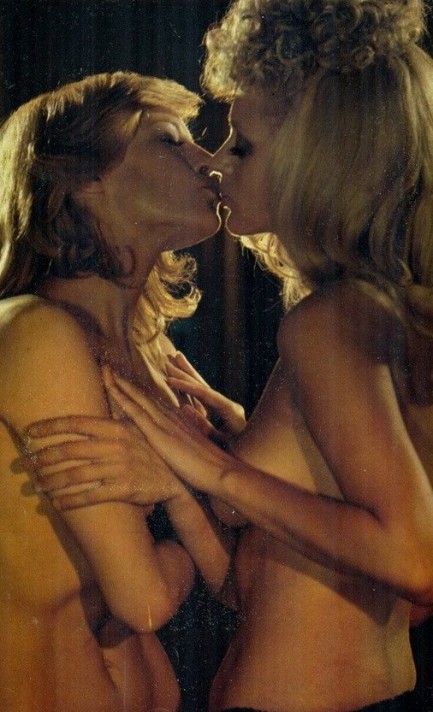 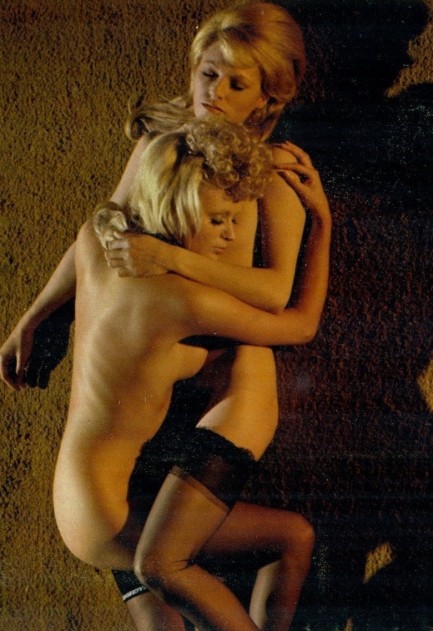 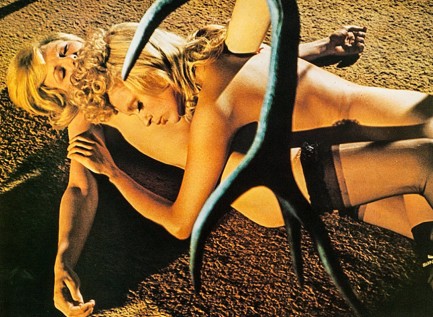 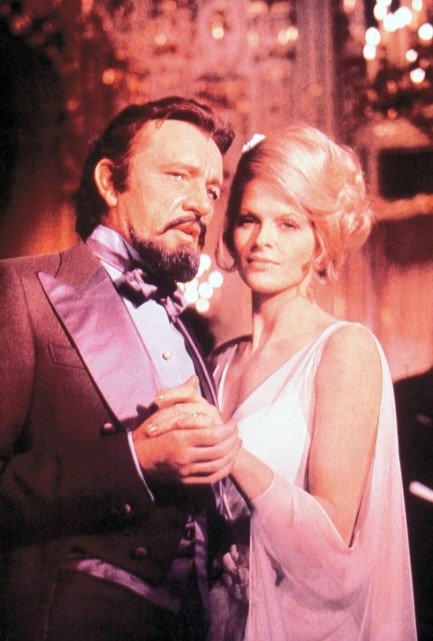 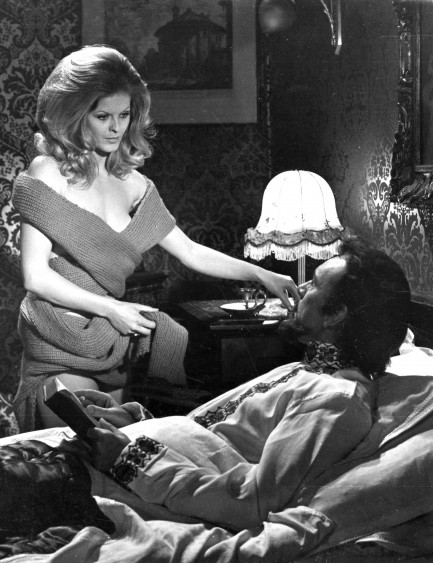 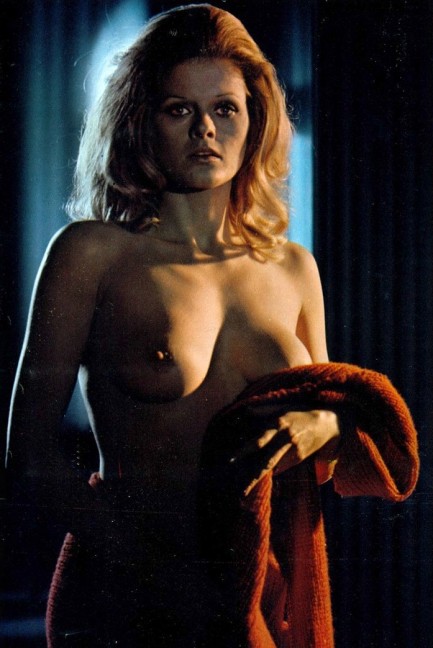 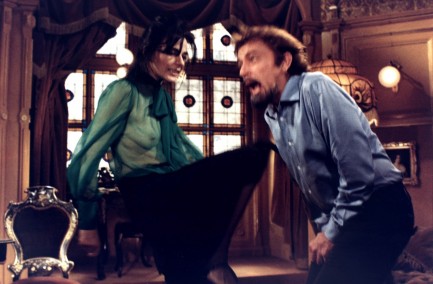 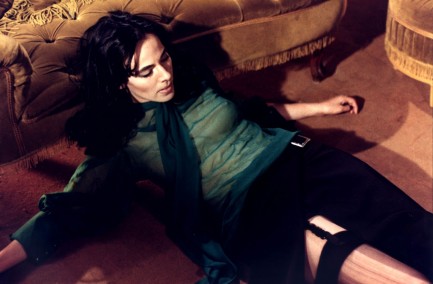 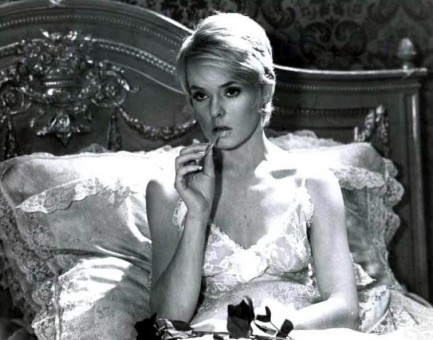 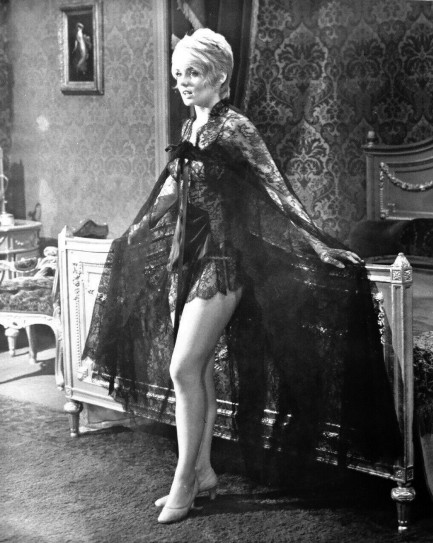 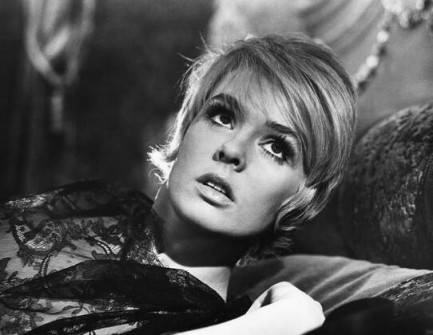 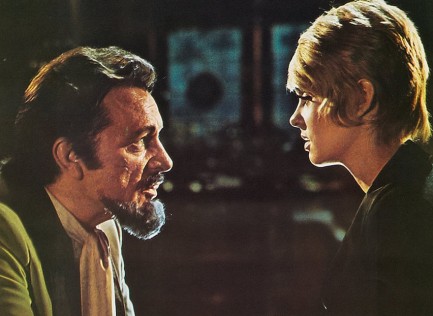 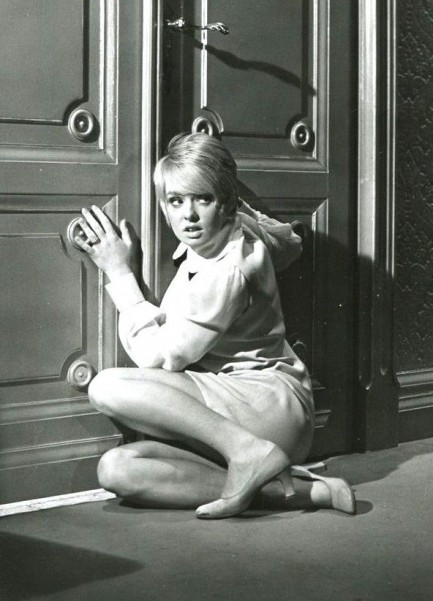 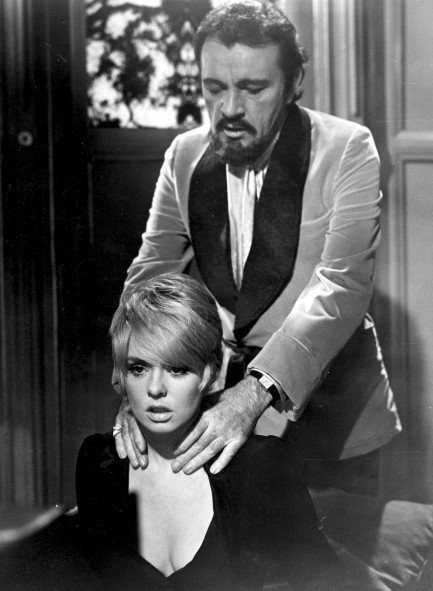
 Garner's portrayal of a classic detective feels a lot like a Rockford Files test run. 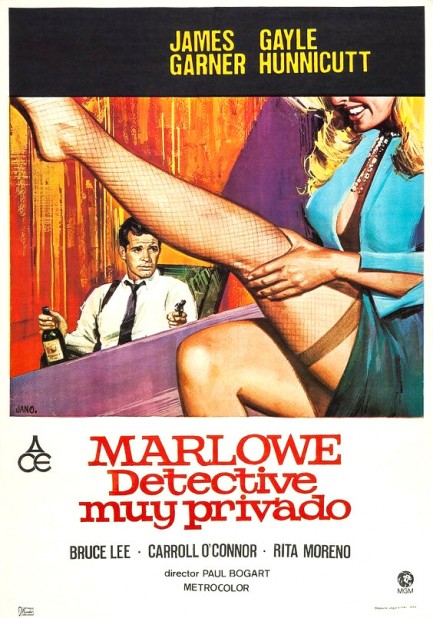
Raymond Chandler's novels have been adapted to the screen several times. One of the lesser known efforts was 1969's Marlowe, which was based on the 1949 novel The Little Sister and starred future Rockford Files centerpiece James Garner as Chandler's famed Philip Marlowe. You see a cool Spanish popster for the movie above, painted by Fernandez Zarza-Pérez, also known as Jano. As usual when we show you a foreign promo for a U.S. movie, it's because the domestic promo isn't up to the same quality. In this case the U.S. promo is almost identical, but in black and white. The choice was clear.
Since you know what to expect from a Chandler adaptation, we don't need to go into the plot much, except to say it deals with an icepick murderer and ties into show business and blackmail. What's more important is whether the filmmakers made good use of the original material, either by remaining true to its basic ideas or by imagining something new and better. They weren't going for new in this case. They were providing a vehicle for the charismatic Garner and ended up with a movie that features him in the same mode he would later perfect in Rockford.
Marlowe has a few elements of note. Rita Moreno plays a burlesque dancer, and it's one of her sexier roles. Bruce Lee makes an appearance as a thug named Winslow Wong. Garner is the star, so it isn't a spoiler to say that Lee doesn't stand a chance. He's dispatched in unlikely but amusing fashion. Overall, Marlowe feels like an ambitious television movie and plays like a test run for Rockford, but it's fun stuff. We recommend it for fans of Chandler, Moreno, Lee, Carroll O'Connor (who co-stars as a police lieutenant), and especially Garner. It premiered in the U.S. in 1969, but didn't reach Spain until today in 1976.
 In a place like Atlantic City there's always one more chance. 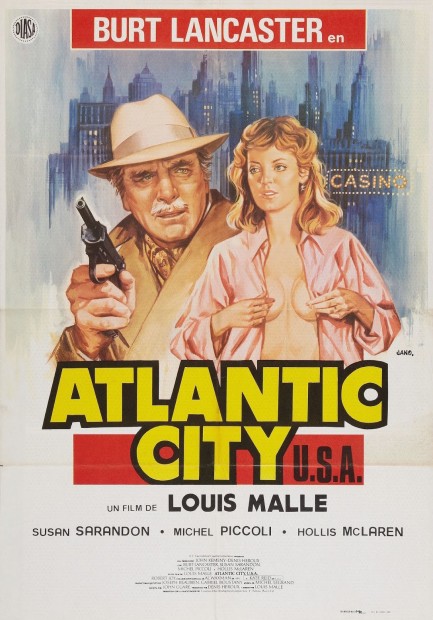
The poster you see above was painted by the Spanish artist Francisco Fernandez Zarza-Pérez, who signed his work as Jano. As you can see, it was to promote Louis Malle's drama Atlantic City, U.S.A. Most sites call the film just Atlantic City, but we're going with what the opening credits called it. Though the movie starred U.S. performers and tends to be thought of as an American effort, it was French produced and premiered all over Europe in 1980 before reaching the States in 1981. It opened in Spain today in 1980 and tells the story of a sixty-something minor crook who finds himself involved with twenty-something hustlers and their sale of stolen drugs. Circumstances place both the party favors and the profits in his hands, and he suddenly has a chance to be the big time mobster he never was.
Not only did Atlantic City, U.S.A. win the Golden Lion at the Venice Film Festival, it's one of the few movies to be nominated for all five major Academy Awards—Best Actor (Burt Lancaster), Best Actress (Susan Sarandon), Best Director, Best Picture, and Best Screenplay. With a résumé like that we don't have to tell you the movie is good. Watch it. You'll like it. The woman on the poster, by the way, looks nothing like Susan Sarandon, but it was early in Sarandon's career, and we suspect Jano wasn't too invested in getting her likeness correct. It was within his capability, certainly—his Lancaster looks great. We don't know why he got Sarandon wrong. Considering how famous she eventually became, we have a feeling he wished he'd done better.  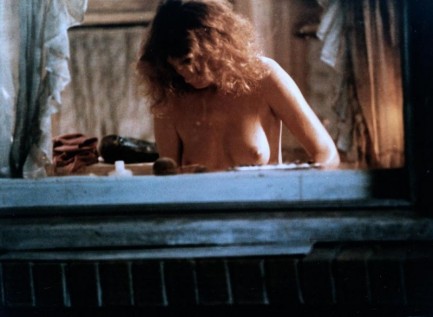 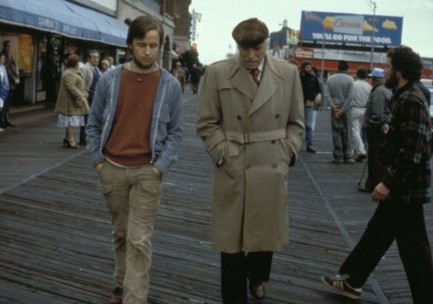 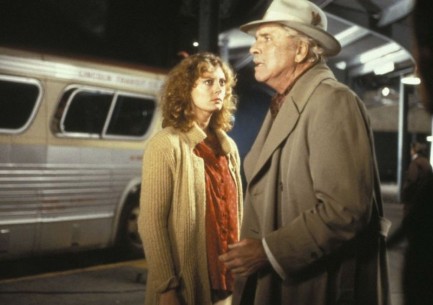 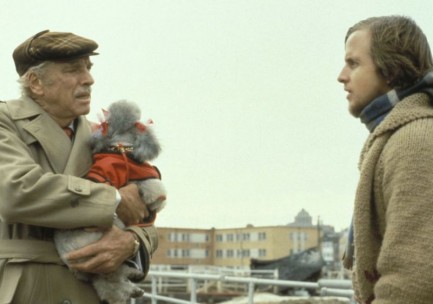 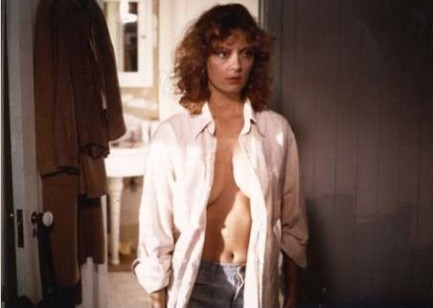 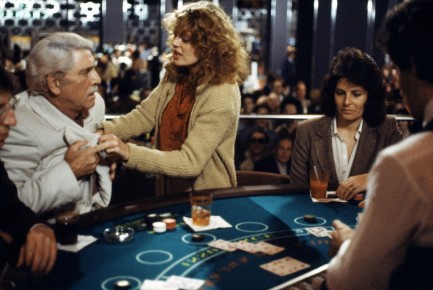 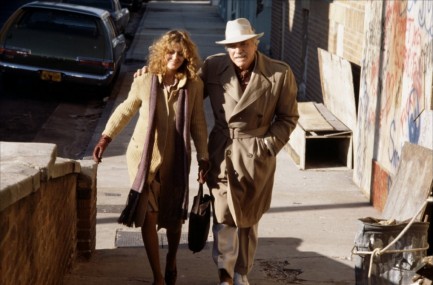 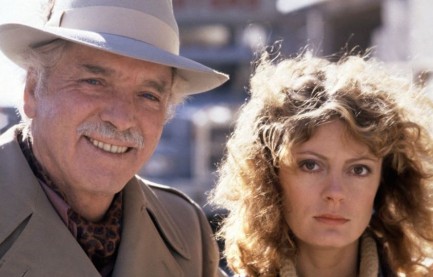
 There's no business like Monroe business. 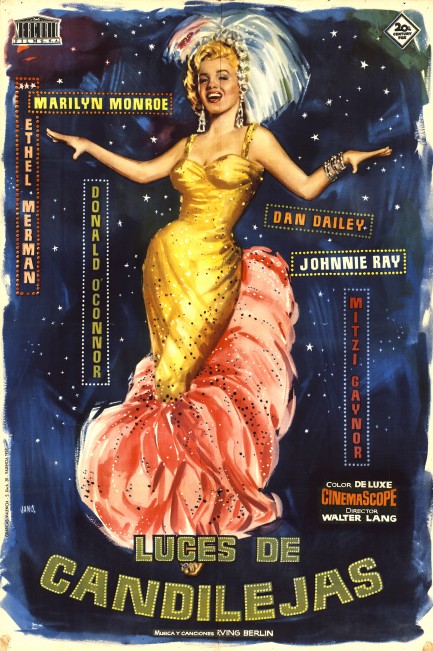
Spanish illustrator Francisco Fernandez Zarza-Pérez painted this beautiful poster for the comedy Luces de candilejas, aka There's No Business Like Show Business, and signed the piece as his alter ego Jano. As you can see by comparing the poster to the set photo below, he covered Monroe's leg, which maybe isn't surprising, since he was working in Franco's fascist Spain. Even so this is by far the best poster we've seen from him. The movie's Spanish title Luces de candilejas translates as “candle lights,” which is appropriate, as Marilyn Monroe gets into the type of moth-to-flame difficulties in which she specialized, with her arrival as a new talent on the Vaudeville scene bringing strife to a show business family. No pulp material here—it's a pure musical, with a lot of performance numbers from Monroe, Mitzi Gaynor, Johnnie Ray, Dan Dailey, and headliners Ethel Merman and Donald O'Connor. The Jano artwork makes the poster a must share, but the film is a pass—not because it's a Vaudeville musical, but because it's bland, due in part to Monroe's minimal screen time. Luces de candilejas premiered in Spain today in 1959, and you can see more Jano here. 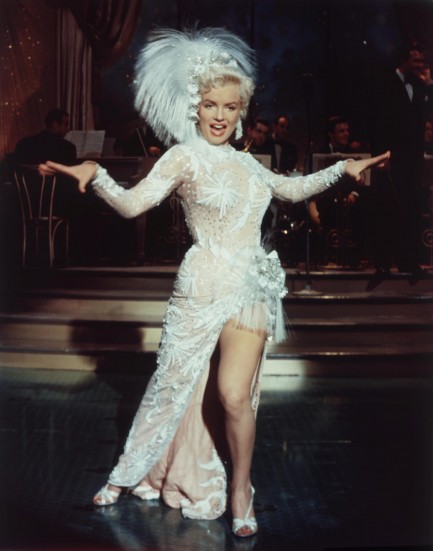
 Perversion never goes out of style. 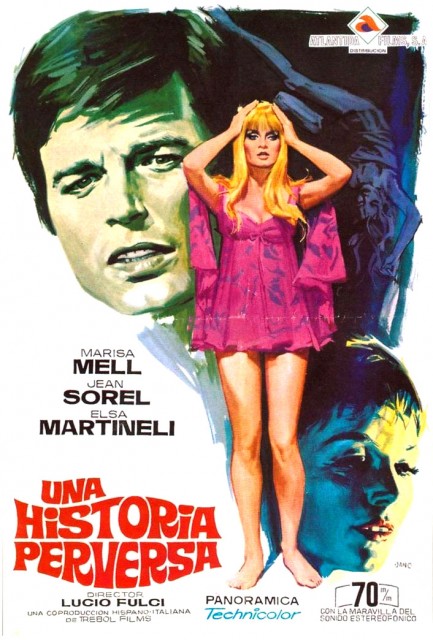
Years ago we briefly discussed the Marisa Mell thriller Una sull’atra and shared an Angelo Cesselon poster made for its Italian run. Well, we're back to the movie today with a poster made for its Spanish run under the title Una historia perversa. The illustration was painted by Francisco Fernandez Zarza-Pérez, who signed his work as Jano, and was one of Spain's more prolific cinematic illustrators. We put together a small collection of his work a while back and you can check that out here. Una historia perversa made its Spanish premiere in Barcelona today in 1969.
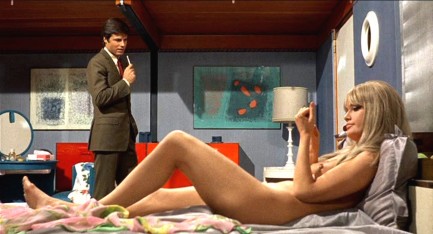
 Argento’s first film was among his most restrained and most successful. 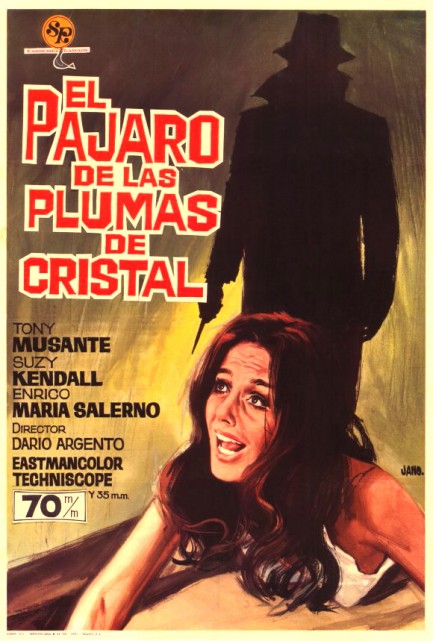 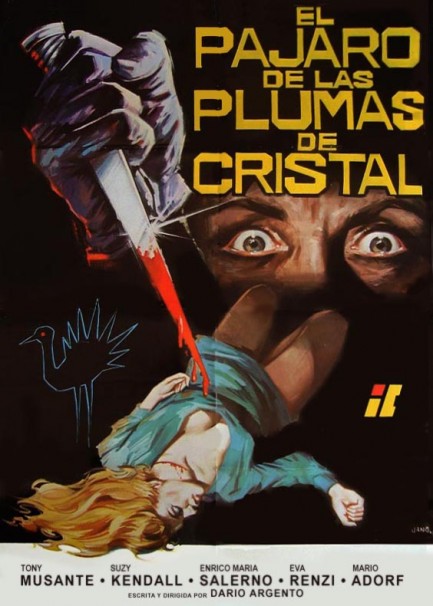
Above we've posted two Spanish one-sheets for El Pajaro de las Plumas de Cristal, aka L’uccello dale piume de cristallo, aka The Bird with the Crystal Plumage. This was horror grandmaster Dario Argento’s first film, a thriller in the Hitchcockian mode about an American in Italy who witnesses an attempted murder. The police make him stay in the country, the would-be killer soon begins stalking him. After an attempt on his life he realizes unmasking the maniac himself is probably his best defense. This was the beginning of a storied career for Argento. In subsequent efforts, he would explore realms of gore Hitchcock probably never dreamt of, but in this early effort he relies on mood to achieve his goals, and the English language version mostly succeeds despite the distraction of some less than breathtaking dubbing. Overall, we consider this well worth a viewing, imperfections and all. The Bird with the Crystal Plumage premiered in Italy today in 1970. Turning to the poster art, it was painted by another grandmaster, Spanish illustrator Francisco Fernandez Zarza-Pérez, who worked under the pseudonym Jano—aka Janus, the two-faced Roman god of doorways, arches, beginnings and endings. Jano painted thousands of pieces beginning in the 1940s, and we’ve cobbled a few more together and posted them below for you to enjoy this lovely Friday. More on Jano later.
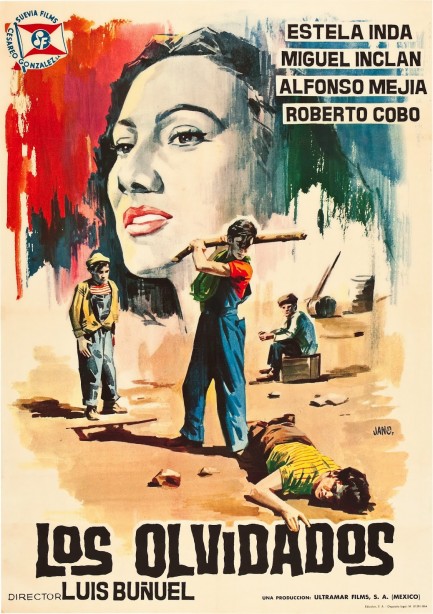 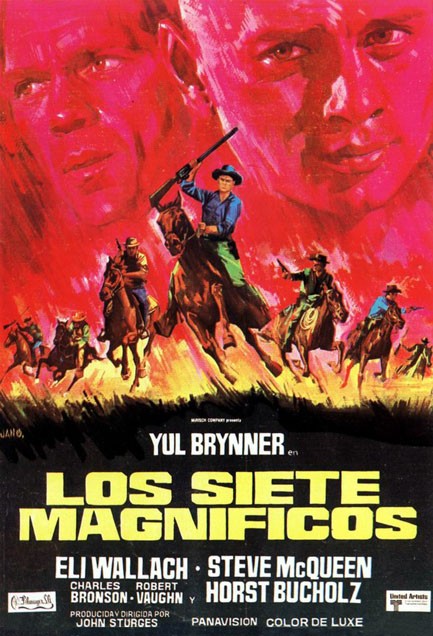 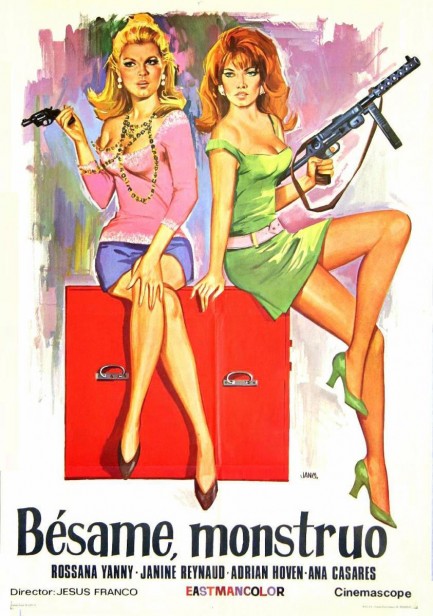 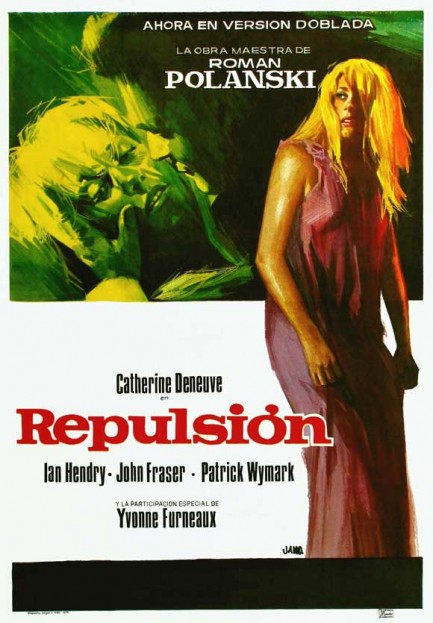 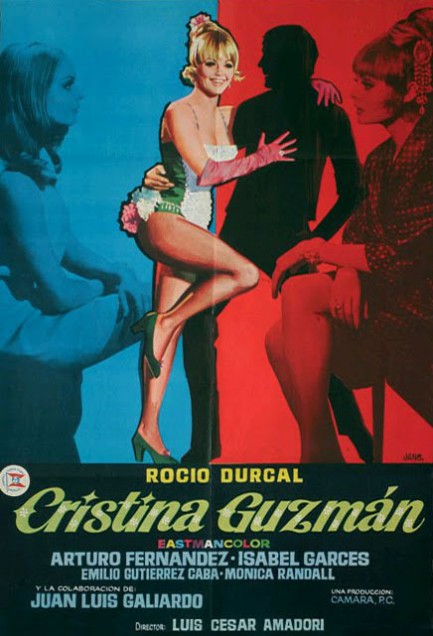 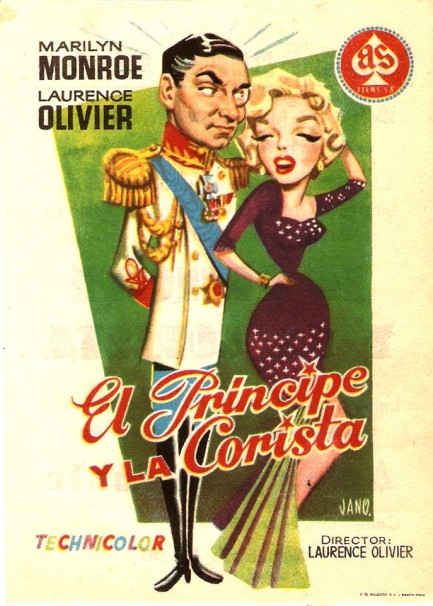 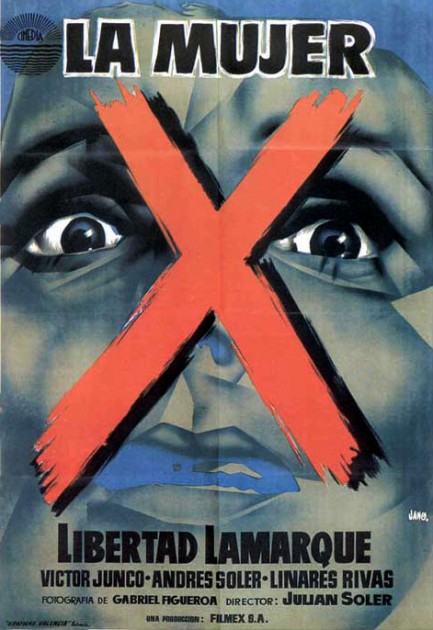 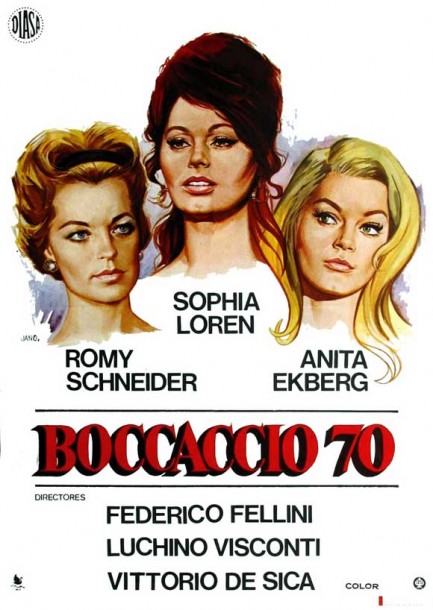 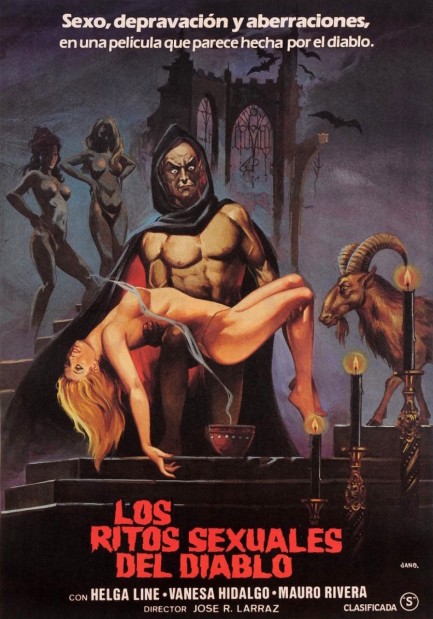 
|
 |

The headlines that mattered yesteryear.
2003—Hope Dies
Film legend Bob Hope dies of pneumonia two months after celebrating his 100th birthday. 1945—Churchill Given the Sack
In spite of admiring Winston Churchill as a great wartime leader, Britons elect
Clement Attlee the nation's new prime minister in a sweeping victory for the Labour Party over the Conservatives. 1952—Evita Peron Dies
Eva Duarte de Peron, aka Evita, wife of the president of the Argentine Republic, dies from cancer at age 33. Evita had brought the working classes into a position of political power never witnessed before, but was hated by the nation's powerful military class. She is lain to rest in Milan, Italy in a secret grave under a nun's name, but is eventually returned to Argentina for reburial beside her husband in 1974. 1943—Mussolini Calls It Quits
Italian dictator Benito Mussolini steps down as head of the armed forces and the government. It soon becomes clear that Il Duce did not relinquish power voluntarily, but was forced to resign after former Fascist colleagues turned against him. He is later installed by Germany as leader of the Italian Social Republic in the north of the country, but is killed by partisans in 1945.
|

|
|

It's easy. We have an uploader that makes it a snap. Use it to submit your art, text, header, and subhead. Your post can be funny, serious, or anything in between, as long as it's vintage pulp. You'll get a byline and experience the fleeting pride of free authorship. We'll edit your post for typos, but the rest is up to you. Click here to give us your best shot.

|
|


 Another of the movies we watched recently was Bluebeard, a castle and dungeon-style, quasi gothic horror flick about a folk tale character who murders a series of wives. Its Spanish poster was the best of those we saw, and we chose today to share it because the film premiered in Spain today in 1974, after opening in the U.S. two years earlier.
Another of the movies we watched recently was Bluebeard, a castle and dungeon-style, quasi gothic horror flick about a folk tale character who murders a series of wives. Its Spanish poster was the best of those we saw, and we chose today to share it because the film premiered in Spain today in 1974, after opening in the U.S. two years earlier. a certain point we suppose money papers over all flaws. Rich or not, though, never marry a guy who sits around with a raptor on his shoulder. And speaking of hunting, we should warn the kind-hearted that there's an extended hunting sequence in Bluebeard, and the animals are killed for real, in detailed action. We're talking several rabbits, a number of birds in flight, a couple of foxes, a boar, and a deer.
a certain point we suppose money papers over all flaws. Rich or not, though, never marry a guy who sits around with a raptor on his shoulder. And speaking of hunting, we should warn the kind-hearted that there's an extended hunting sequence in Bluebeard, and the animals are killed for real, in detailed action. We're talking several rabbits, a number of birds in flight, a couple of foxes, a boar, and a deer.

































